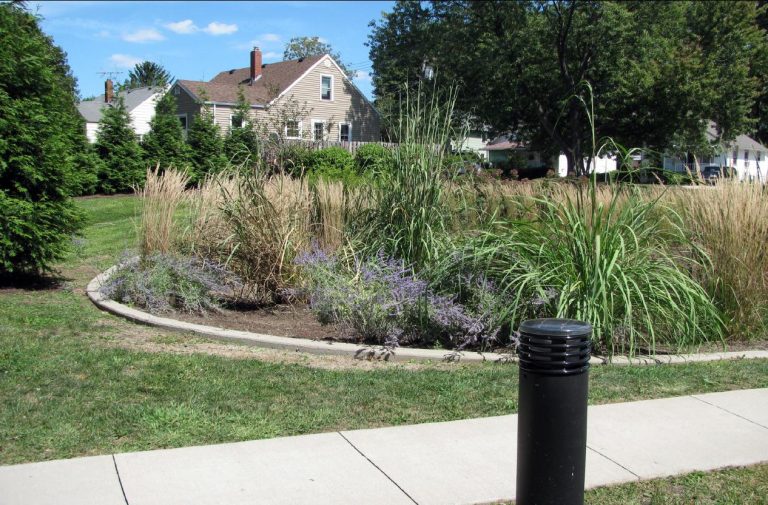Photo credit: City of Cuyahoga Falls.
There is growing acceptance that green infrastructure can do a good job of managing smaller rainfall events. It can eliminate most runoff and treat any runoff that is discharged, while providing many other co-benefits. But when it comes to managing larger rainfall events – those in the top 10% of events by volume in a given year – green infrastructure is often written off.
Recent draft guidelines for flood resilient communities developed by the Intact Centre on Climate Adaptation embody this perspective. While there is mention of low impact development and green infrastructure, the report states that “usually, traditional stormwater design features, such as stormwater end-of-pipe facilities, continue to be required to accommodate large, infrequent rainfall events.” The recommendations focus heavily on these traditional design features.
As long as green infrastructure is thought of as a bonus, “nice-to-have” feature that doesn’t replace any services provided by grey infrastructure, we will not see widespread implementation. The Green Infrastructure Ontario Coalition will be submitting comments supporting the use of green infrastructure for creating flood-resilent communities to the Intact Centre. If you’d like to submit your own comments on the standards, you can do so by sending them to Natalia Moudrak before October 31st.
There are numerous demonstration projects that show that green infrastructure can help with flooding issues – from retrofits that solve problems at the lot-level, to neighbourhood retrofits which eliminate runoff from most rain events and delay peak flows from extreme events. Just as with traditional stormwater systems, overflows need to be designed to channel excess water during extreme rainfall events.
Some examples of projects on the ground that have proven to reduce flooding:
- Lakeview neighbourhood retrofit by Credit Valley Conservation, which in three years of monitoring from 2012 to 2015 reduced peak flows from 74% to 100% for storms from the 2 to 10 year return period, and eliminated virtually all runoff from events less than 30mm.
- Elm Drive right of way bioretention in Mississauga, which, during monitoring from 2011 to 2015, reduced peak flows by 88-90% for events between a 10 and 50 year return period. During the July 8, 2013 storm, which far exceeded the 100 year storm, in which 105mm of rain fell over 5 hours, the installation reduced runoff volumes by 30%, reduced peak flows by 60%, and delayed peak flow by 20 minutes, taking pressure off of downstream systems, despite not being designed for a storm of this magnitude.
- Miracle on Elmer Avenue in Los Angeles, in which a green infrastructure retrofit designed to improve water quality solved a flooding problem, as well as improving quality of life in the area.
- Rain Garden Reserve, Cuyahoga Falls, Ohio in which four frequently flooded properties were bought up and turned into a pocket park with rain gardens, with funding from FEMA. When four inches of rain fell on the city in 2014, no damages were reported in the neighbourhood around the rain gardens.
A current research project by Dr. Andy Binns and Dr. Ed McBean at the University of Guelph is using modeling to investigate how widespread low impact development can contribute to flood reduction.
There is also significant evidence to support the flood prevention ecosystem services provided by upstream natural infrastructure, such as wetlands and forests. A recent study by the Intact Centre (the same centre from which the flood-resilient community standards have been released) shows that maintaining wetlands can reduce damages related to flooding by up to 38%. A report from the European Environment Agency estimates that watersheds with 30% forest cover retain 25% more water than those with only 10%. This natural infrastructure must be maintained and valued for these important services. Gibsons, BC has been a pioneer in valuing its natural assets, and other municipalities are now joining in.
Stormwater management has evolved quickly during its short lifespan – design for water quality treatment and flood control only have been standard over the last three to four decades, and many areas of our cities were built before one or both of these were required. Flood plains and watershed-scale impacts of development are still not fully understood.
There is no question that we need to make sure that our new communities are flood-resilient. We must look forward when designing new communities and use stormwater management systems that provide the best level of service for both smaller and larger rainfall events and preserve the ecosystem services provided by natural areas.

